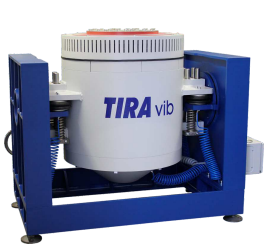Manufacturer: Tira / Origin: Germany
TIRA shakers reproduce vibration environment under laboratory conditions for testing the dynamic strength and the reliability in all fields of applications of vibration testing technology.
On laboratory conditions sine, random, mixedmode and shock tests are reproduced with the help of complete vibration testing systems.
These systems are indispensable in the field of quality assurance, research and development.
Specifications:
| Model: TV 59335/AIT-440 |
| Rated peak force Sinepk/RandomRMS: 35000/32000/105000 N |
| Frequency range: 5 - 3000 Hz |
| Main resonance frequency: > 2400 Hz |
| Max. displacement Peak-Peak: 50.8 mm |
| Max. velocity Sine/Random/Shock: 2.0/1.8/2.5 m/s |
| Max. acceleration Sine/Random/Shock: 100/67/207 g |
| Suspension stiffness: 150 N/mm |
| Effective moving mass: 38.0 kg |
| Max. weight tested: 610 kg |
| Weight with trunnion RIT/AIT/LB: 2350/2700/2250 kg |
| Magn. stray field std./low degaussing: <1.5/<0.8 mT |
| Armature diameter: 440 mm |
| Required compressed air supply (load-dependent): 600-1000 kPa |
| Interlocks: Temperature, displacement, cooling air, overcurrent, compressed air |
A vibration test system is a type of environmental testing equipment that is used to simulate mechanical vibrations and assess the response of materials, components, and systems to those vibrations. The system typically consists of a vibration table or shaker, a power amplifier, and a control system.
During testing, the test specimen is attached to the vibration table or shaker, and the system is used to generate mechanical vibrations at various frequencies and amplitudes. The test specimen's response to these vibrations is then measured and analyzed, typically using accelerometers or other types of sensors.
Vibration test systems may be used to assess the durability, reliability, and performance of a wide range of products and components, including automotive and aerospace components, electronic devices, and medical equipment. They are often used to test products and components for compliance with industry standards and regulations, such as MIL-STD-810 for military equipment and ASTM standards for commercial products.
Vibration test systems may be capable of producing various types of vibration, including sine, random, and shock vibration, and may be able to simulate a range of environmental conditions, including temperature, humidity, and altitude.
Overall, vibration test systems are essential tools for engineers, researchers, and quality control professionals who need to evaluate the performance and reliability of products and components under various types of mechanical stress.

